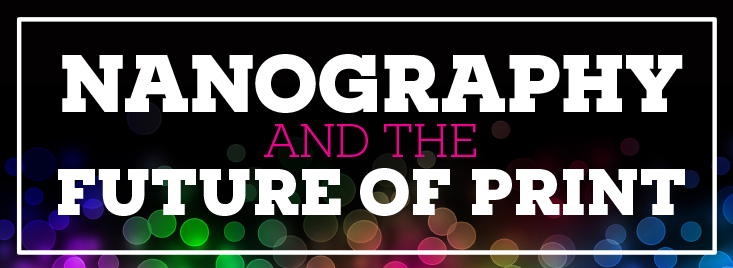In the printing market, 98% of pages are printed using digital technology, but use technology that is essentially 100 years old. One of the main reasons is that when modern digital printing applies ink directly to paper, the wet ink penetrates the paper and many of the pigment particles end up beneath the paper’s surface becoming inefficient absorbers of light. Nanography, differs from other printing technologies, especially from Inkjet printing, because it uses an innovative system and printing process that employs Landa NanoInk, a proprietary water-based ink with nano-pigment particles that measure tens of nanometers in size.
The nanography process begins with Landa NanoInk, which is water-based and contains pigments with a diameter that measures in the tens of nanometers. This ink is ejected onto a conveyor blanket that is heated. Every row of ink ejectors adds a unique colorant, CMYK or CMYKOVG. The water quickly evaporates, causing the droplets of ink to flatten out and blend into a dry, super-thin, polymeric film. This color image, about 500 nm in thickness, is transferred from the heated blanket onto the paper or other surface. This image layer in abrasion resistant and laminated to match the glossiness of the paper it adheres to. The image that is produced has dots that are exceptionally round with edges that are incredibly sharp.
Advantages of Nanographic Printing
- One of the biggest advantages of nanographic printing over ink jet and other types of printing is that the nano-pigments in the ink are excellent at absorbing light. Thus permits images with ultra-sharp dots of extremely high gloss fidelity, high uniformity and a broad CMYK colour gamut
- The nanographic printer create images that are up to ten times thinner than other printing processes.
- Images are both abrasion-resistant and scratch-resistant.
- printing method also doesn’t require special paper or paper with special coatings. Nanographic images can be successfully transferred to nearly every type of paper available, without special primers or coatings.
- NanoInk is also water-based and eco-friendly
Disadvantages of Nanographic Printing
The main disadvantage to nanographic printing is said to be the price of Nanography printers, however this technology has the capacity for the lowest cost-per-page of any digital printing method available.
Four naographic printing press models are currently available from Landa, and more are being developed. They are gradually penetrating the digital printing market and are in the process of developing print technology that is higher quality, less expensive, and more efficient than current printing methods.
We can say that Nanography is destined to become the first digital printing process that can compete in the mainstream market. Nanographic printing may never replace ink jet printing as the most common type of commercial digital printing, but their products are unique and they are constantly working on developing new technology.




